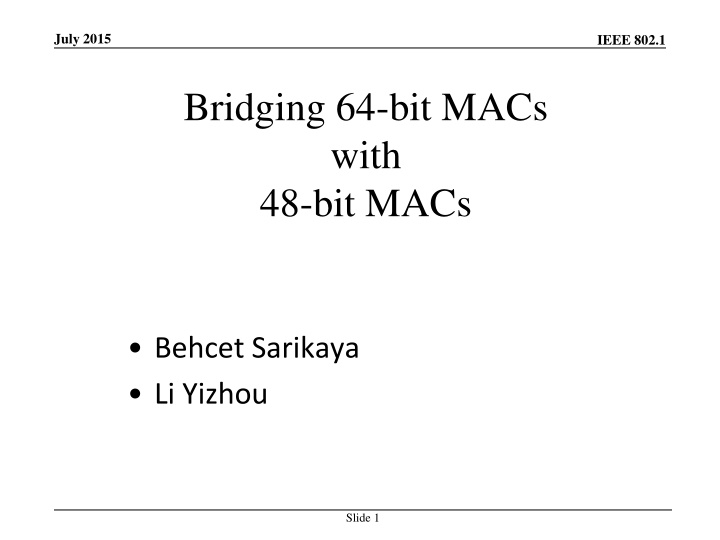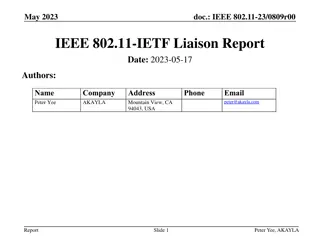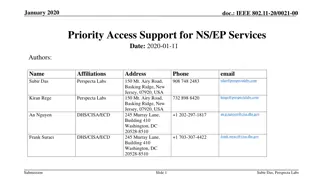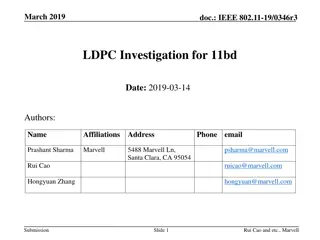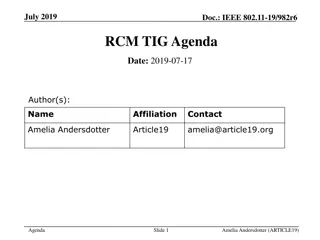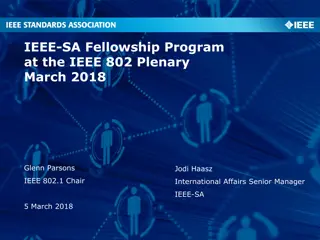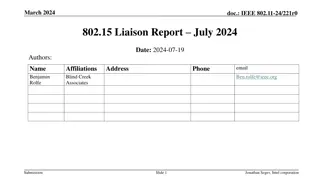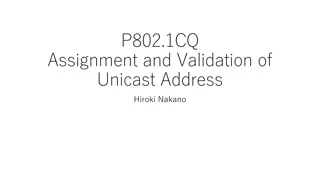Bridging 64-bit MACs in IEEE 802.1
This content delves into bridging challenges between 64-bit MACs and 48-bit MACs in IEEE 802.1 standards, emphasizing issues like address format incompatibilities, MAC frame formats, adaptation, and routing protocols. It discusses scenarios for bridging in PAN networks and the complexities in addressing and routing protocols for IoT devices.
Download Presentation

Please find below an Image/Link to download the presentation.
The content on the website is provided AS IS for your information and personal use only. It may not be sold, licensed, or shared on other websites without obtaining consent from the author.If you encounter any issues during the download, it is possible that the publisher has removed the file from their server.
You are allowed to download the files provided on this website for personal or commercial use, subject to the condition that they are used lawfully. All files are the property of their respective owners.
The content on the website is provided AS IS for your information and personal use only. It may not be sold, licensed, or shared on other websites without obtaining consent from the author.
E N D
Presentation Transcript
July 2015 IEEE 802.1 Bridging 64-bit MACs with 48-bit MACs Behcet Sarikaya Li Yizhou Slide 1
Current IoT Networking July 2015 IEEE 802.1 IETF is developing IPv6 solutions for addressing and routing in the PAN IETF is developing only IPv6 solutions on IoT in an effort to push IPv6 IPv6 solution requires home network to terminate IP and then restart IPv6 routing downstream 802.3 frame from IoT server in the Internet can not be bridged at PAN coordinator Layer 2 is not end-to-end Slide 2
64-bit MACs vs 48-bit MACs IEEE 802.1 In the PAN, there are nodes connected to two IEEE 802 technologies like 802.15 and 802.3, PAN coordinator and intermediate routers if any This brings MAC frame format incompatibilities especially MAC addresses, MPDU and timing issues Slide 3
Where to Bridge in the PAN? IEEE 802.1 Scenario 1. At the PAN Coordinator Scenario 2. At lower levels in the PAN We need to add other scenarios like IPv4 usage Slide 4
Frame Formats IEEE 802.1 802.15.4 MAC Data Frame Octets:2 1 4 to 20 variable 2 Data sequence number Frame check sequence Frame control Address information Data payload MAC footer MAC header MAC Payload Only 802.15.4 MAC has 64 bit MAC addresses, others like Bluetooth or 802.15.1 are 48 bit 802.3 MAC Data Frame 8 6 2 0 to 1500 0 to 46 4 6 Destination address Source address Preamble Type Data Pad Checksum Slide 5
802.15.4 to 802.3 Adaptation or Bridging IEEE 802.1 Address bridging: 802.15.4 MAC address long format is 64 bits or 8 octets, 802.3 supports 48 bit MAC address, i.e. 6 octets MPDU bridging: Some 802.15.4 PHY limit MPDUs to 127 octets, 802.3 has 1500 octet MPDUs Timing bridging: See later Slide 6
MAC address adaptation <month year> IEEE 802.1 48-bit MAC addresses can be converted (mapped) into 64-bit addresses as in IEEE Guidelines standards.ieee.org/develop/regauth/tut/eui64. pdf Unfortunately it was found out that IEEE Guidelines was wrong, so no solution for 48-bit MAC to 64-bit MAC exists No solution for 64-bit to 48-bit MAC address conversion New developments in this area include 802.1 PAR dealing with local addresses and Layer 2 Routing protocol Slide 7
802.1 Local Address Study Group IEEE 802.1 started a Study Group on Local addresses, http://www.ieee802.org/1/pages/lasg.html 48-bit MAC addresses are depleting like IPv4 addresses because of Data Center, IoT, etc. Local address SG will recommend how to use local addresses, 7th bit in Byte 1 set to 1 Local address SG will develop protocols to acquire local addresses Address Bridging: 64-bit to 48-bit address adaptation work is needed in 802.1 Local addresses can be used by the bridge during address bridging Slide 8 July 2015 IEEE 802.1
L2R July 2015 IEEE 802.1 IEEE 802.15 Task Group 10 finished developing a new protocol on Layer 2 routing in Wireless Personal Area Network (WPAN) After the incoming frame if bridged to 802.15 network, L2R protocol can route it to the destination Slide 9
MPDU Size Adaptation IEEE 802.1 802.15 amendments that can support 1500 octets: 802.3d, 802.15.4g, 802.15.4m Other 802.15 technologies that have smaller MPDU sizes like 127 octets in 802.15.4.e Ethernet can carry frame sizes 64 to 1500 octets MPDU bridging: Bridge may receive frames longer than 802.15 can handle, fragmentation/reassembly is needed in 802.15 Slide 10
Timing Considerations July 2015 IEEE 802.1 Bridge keeps a frame for a maximum of 1sec until it reaches the destination This value can be increased to 4sec maximum value 802.15 has sleeping nodes (4e, 4f, 4k, 15.1, 15.6) Timing Bridging: The work has to address this issue in 802.1 There are wakeup frames defined in 802.15.4e, 4k Ways to wake up in other cases Slide 11
MPDU Size for 802.15.4 July 2015 IEEE 802.1 802.15.4 amendments that can support 1500 octets: 802.15.4g, 802.15.4m Others like 802.15.4k do not Limit the adaptation to those that can support Limit point to point link establishment to those that can support Slide 12
July 2015 IEEE 802.1 Thank you! Questions Slide 13
